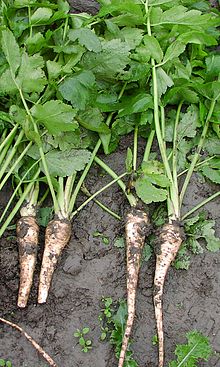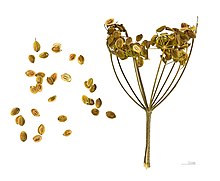
Back جزر أبيض Arabic جزر ابيض ARZ Pastinaca sativa AST Əkin cırhavucu Azerbaijani Пастернак үләне Bashkir Pastarnuoks BAT-SMG Пастарнак пасяўны Byelorussian Пастарнак BE-X-OLD Обикновен пащърнак Bulgarian পার্সনিপ Bengali/Bangla
| Parsnip | |
|---|---|

| |
| Scientific classification | |
| Kingdom: | Plantae |
| Clade: | Tracheophytes |
| Clade: | Angiosperms |
| Clade: | Eudicots |
| Clade: | Asterids |
| Order: | Apiales |
| Family: | Apiaceae |
| Genus: | Pastinaca |
| Species: | P. sativa
|
| Binomial name | |
| Pastinaca sativa | |


The parsnip (Pastinaca sativa) is a root vegetable closely related to carrot and parsley, all belonging to the flowering plant family Apiaceae. It is a biennial plant usually grown as an annual. Its long taproot has cream-colored skin and flesh, and, left in the ground to mature, becomes sweeter in flavor after winter frosts. In its first growing season, the plant has a rosette of pinnate, mid-green leaves. If unharvested, it produces a flowering stem topped by an umbel of small yellow flowers in its second growing season, later producing pale brown, flat, winged seeds. By this time, the stem has become woody, and the tap root inedible. Precautions should be taken when handling the stems and foliage, as parsnip sap can cause a skin rash or even blindness if exposed to sunlight after handling.[2]
The parsnip is native to Eurasia; it has been used as a vegetable since antiquity and was cultivated by the Romans, although some confusion exists between parsnips and carrots in the literature of the time. It was used as a sweetener before the arrival of cane sugar in Europe.[3]
Parsnips are usually cooked but can also be eaten raw. The flesh has a sweet flavor, even more so than carrots, but the taste is different. It is high in vitamins, antioxidants, and minerals (especially potassium); and also contains both soluble and insoluble dietary fiber. Parsnips are best cultivated in deep, stone-free soil. The plant is attacked by the carrot fly and other insect pests, as well as viruses and fungal diseases, of which canker is the most serious.[4]
- ^ "Pastinaca sativa". Germplasm Resources Information Network. Agricultural Research Service, United States Department of Agriculture. Retrieved 2008-03-02.
- ^ Fauzia, Miriam (23 June 2021). "Fact check: Contact with wild parsnip harmful to humans and animals". USA Today. Retrieved 16 June 2023.
- ^ Cite error: The named reference
Venema 2015was invoked but never defined (see the help page). - ^ Cite error: The named reference
Plantvillage PSUwas invoked but never defined (see the help page).